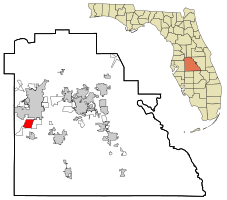Medulla, Florida facts for kids
Quick facts for kids
Medulla, Florida
|
|
|---|---|

Location in Polk County and the state of Florida
|
|
| Country | United States |
| State | Florida |
| County | Polk |
| Area | |
| • Total | 5.65 sq mi (14.64 km2) |
| • Land | 5.60 sq mi (14.50 km2) |
| • Water | 0.05 sq mi (0.14 km2) |
| Elevation | 161 ft (49 m) |
| Population
(2020)
|
|
| • Total | 10,871 |
| • Density | 1,941.94/sq mi (749.74/km2) |
| Time zone | UTC-5 (Eastern (EST)) |
| • Summer (DST) | UTC-4 (EDT) |
| Area code(s) | 863 |
| FIPS code | 12-43925 |
| GNIS feature ID | 0286674 |
Medulla is a small community in Polk County, Florida, United States. It is not a city but a special area called a census-designated place (CDP). This means it's a place the government counts for population, even though it doesn't have its own city government.
Medulla is located in western Polk County. It is part of a larger area that includes the cities of Lakeland and Winter Haven. Medulla is known as a nice place to live, with many homes. It sits just south of Lakeland and north of Mulberry. It also borders Lakeland Highlands. Together, Medulla and Lakeland Highlands make up a big part of what people call "south Lakeland."
In 2010, about 8,892 people lived in Medulla. By 2020, the population grew to 10,871. Even though it's not a city, people in Medulla use Lakeland's zip codes, which are 33811 and 33813.
Contents
Exploring Medulla's Geography
Medulla is located in the sunny state of Florida. It covers a total area of about 5.7 square miles (14.7 square kilometers). Most of this area is land. Only a very small part, about 0.04 square miles (0.1 square kilometers), is water. This means Medulla is mostly dry land, with very little water within its borders.
Medulla's Past: A Brief History
The community of Medulla has an interesting history. It used to be called Spring Hill. In 1881, a post office was opened in Medulla. This post office helped people send and receive mail. It stayed open for many years, finally closing in 1909.
The name "Medulla" was chosen because of its location. It was an important stop on the stagecoach route between two other towns, Bartow and Fort Meade. This connection was like the medulla oblongata in the brain. The medulla oblongata connects the brain to the spinal cord. So, the name Medulla shows how this community connected other places.
Medulla grew a lot in the 1990s and early 2000s. Many new homes were built during this time. One large community built was called Deer Brooke. After that, many other smaller neighborhoods were also developed.
Understanding Medulla's Population
| Historical population | |||
|---|---|---|---|
| Census | Pop. | %± | |
| 2020 | 10,871 | — | |
| U.S. Decennial Census | |||
We can learn about the people living in Medulla by looking at information from the census. A census is like a big count of everyone in a place.
In the year 2000, there were 6,637 people living in Medulla. These people lived in 2,567 households. A household is a group of people living together in one home. About 1,791 of these households were families.
The population density tells us how many people live in each square mile. In 2000, about 1,169 people lived in each square mile of Medulla. There were also about 2,739 housing units, which are places where people can live.
Most people in Medulla in 2000 were White. About 84.5% of the population was White. Other groups included African American people (11.65%), Asian people (0.62%), and Native American people (0.03%). Some people were from other races or from two or more races. About 5.2% of the population was Hispanic or Latino.
Many households in Medulla had children. About 35.6% of households had children under 18 living there. More than half of the households (55.6%) were married couples living together. Some households (11.1%) had a female head of household without a husband.
The age of people in Medulla varied. About 26.4% of the population was under 18 years old. About 33.6% were between 25 and 44 years old. The median age was 34 years. This means half the people were younger than 34, and half were older.
See also
 In Spanish: Medulla (Florida) para niños
In Spanish: Medulla (Florida) para niños

